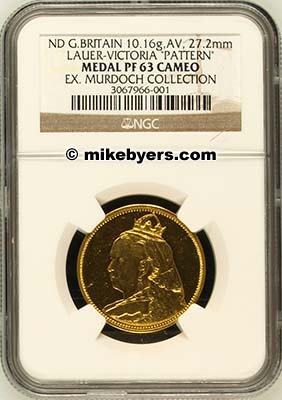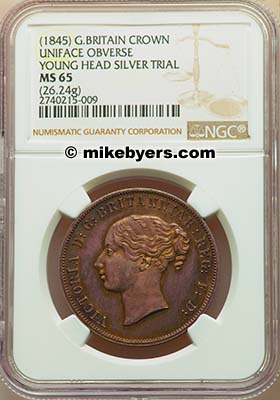Glossary
CategoriesBonded CoinsBroadstrikes Brockages Counterbrockages Die Adjustment Strikes Die Caps Die Trials Double Denomination Double/Multiple Strikes Dual Countries Dual Mint Marks Essay Trial Strikes Experimental Blanks Experimental Strikes Experimental Surface Feeder Finger Strikes Foreign Coins Struck on U.S. Planchets Galvanos Gold Die Trials Gold Errors Gold Off-Metals Hub Trials Indents Intentional Errors Martha Washington Test Pieces Mated Pairs Mules Multiple Errors Off-Centers Off-Metals Overstrikes Pattern Die Trials Pattern Errors Pattern Mules Plaster Models Platinum Errors Proof Errors SMS Mint Errors Specimens Spectacular Errors Struck Scrap Struck Thru Transitional Errors Two-Headed Coins Two-Tailed Coins Uncanceled Dies Uniface Die Trials Unique Coins |
  Pattern Die TrialsMetals other than the adopted composition are frequently used to strike die trials. They are sometimes struck in copper and white metal. Other times they are struck in softer metals like tin or lead. There are even some examples struck in wax and on cardboard. Die Trials that are struck in gold are exceeding rare. U.S. die trials are listed in the Judd reference book of patterns and die trials. Technically die trials and hub trials are part of the pattern family. However, in the last 5 years the coin market has drastically changed directions. Many pattern enthusiasts have always wanted a die trial to go along with the specific type or denomination of pattern(s) that they collect. A new demand has emerged for die trials, hub trials and splashers. Collectors of major mint errors are placing these in their collections because they are unusual, exotic and unique. Even though they are not mint errors, they are aggressively sought after by people who collect off-metals, broadstrikes, uniface strikes and coins struck on larger planchets. In addition, since many of these are struck from incomplete dies and hubs, the design may be only a partial portrait or with parts of the legend and date missing. Pictured above are two unique Great Britain discovery pattern die trials designed by L. C. Lauer, who was a famous German engraver who designed well known gold patterns. The first is a unique gold pattern that portrays a new portrait of Queen Victoria on the obverse. It is technically an obverse die trial and is uniface since there is no design or denomination on the reverse. This Proof 63 Lauer gold pattern obverse die trial is unique since it is only of Queen Victoria's portrait. The second is a unique Great Britain Silver Crown Die Trial Piedfort Pattern. It was struck in 1845 with the "Young Head" portrait that was first used in 1839 when the Royal Mint in London struck proof Crowns. |



